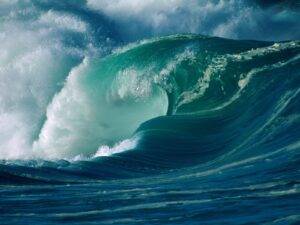
Numerical models are based on the fundamental laws of science which are universal and applicable to many fields, especially geophysics. As a geophysicist interested in predictive applications of near-surface geohazard modeling, I am familiar with solving problems using equations that govern the way waves move through a medium, such as seismic waves traveling through the Earth’s lithosphere. Models are built upon equations that are broken down from scientific laws (such as the laws of conservation, mechanics, gravity, and many others) so that they can simulate the way our Earth and universe actually work. Because these laws are universal, they can be linked across very different fields of science. For example: the laws of conservation of energy, mass and momentum are used to form the equations that could model a tsunami wave propagating across the Pacific Ocean. Similarly, the same laws might be used (with different conditions, assumptions, and variables) in order to model a pressure wave moving through a rock sample in the core of a Super-Earth.
The Carnegie Geophysical Lab has a weekly seminar series that is free and open to the public on Mondays at 11:00am. The lab hosts a different speaker every week and it is a great opportunity to hear some of the world’s top scientists talk about their work at the forefront of geophysics research. I attended the talk this week by Dr. June Wicks from Princeton University titled “From Super-Earth interiors to our own Earth’s surface, using dynamic compression to study our universe” and wanted to share a bit of what I learned about the crossover of fundamental scientific laws within the wide field of geophysical modeling.
Dr. Wicks is a young geophysicist who started her postdoc at Princeton immediately after finishing her PhD at Caltech just 3 years ago. Her research is in a rapidly-growing field of geophysics called dynamic compression, which is a frontier for studying high-pressure mineral physics. This work is impactful for geophysicists who study high-pressure environments and want to understand mantle/core dynamics of the Earth. Dynamic compression allows scientists to study the pressure-density behavior of certain minerals in environments that are extremely difficult to replicate, like the core of the Earth or a Super-Earth, where temperatures and pressures are unimaginably high. It involves concentrating extremely powerful laser pulses onto a very small (100’s of micrometer scale) portion of a mineral sample and then measuring how the shock wave of pressure moves through the sample. Results indicate the importance of understanding a planet’s chemical makeup before accurately modeling its interior. In the future, these studies will help scientists better understand planet-forming impacts, meteorite impacts and crater properties, and the pressure/temperature environment at the core of a super planet. For example, scientists who want to answer questions like “How did this newly discovered planet form?” and “How does the presence of a certain mineral affect my mantle convection model?” would be particularly interested.
For me, a geophysicist who is more focused on near-surface modeling, an interesting take away was that Dr. Wicks’ pressure-response models are based on the fundamental conservation of mass, momentum, and energy equations, which are the same equations used in hydrologic modeling (tsunamis, water flow, flooding) and seismic wave modeling (earthquakes, explosions). Though the equations used in a hydrologic model and the equations in Dr. Wicks’ pressure-response model wouldn’t look very similar to each other, they are based on the same fundamental laws. This makes sense, if you can imagine that shock waves would only be governed by the same physical principles as other kinds of waves, like water and seismic. While this may seem like an obvious realization to some, it is one that scientists often overlook as we home in on the fine points of our respective fields of study.
If you’d like to read more, Dr. Wicks’ website and GoogleScholar page contain more information on her research and some of her publications, many of which are available without journal subscriptions.